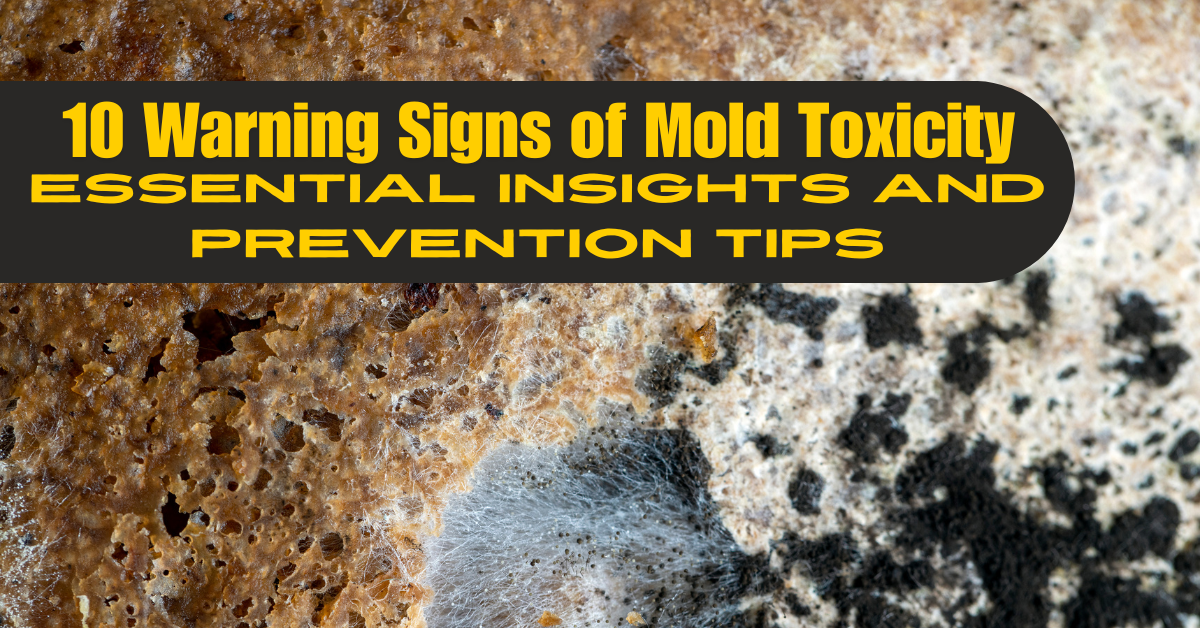
Introduction
Mold toxicity, often hidden and underestimated, poses significant health risks that can impair your quality of life. It thrives in damp and poorly ventilated areas, making seemingly benign spots like basements and bathrooms potential hazards. Recognizing the signs of mold exposure is critical, as it can stealthily affect health long before visible manifestations prompt action. This article aims to educate about the warning signs of mold toxicity, explaining each in detail and offering preventive strategies to safeguard your health effectively.
Understanding Mold and Its Impact on Health
What is Mold?
Mold is not just an unsightly spot on your walls; it is a living organism, a type of fungus that grows in multicellular filaments called hyphae. These fungi are not only common but also incredibly resilient, capable of growing anywhere there is moisture and organic material to consume. Molds reproduce by releasing tiny, lightweight spores into the air, which can then start new mold colonies where they land, provided conditions are right. This resilience makes mold a persistent and often troublesome presence in homes.
How Mold Affects Your Health
Mold can have a myriad of effects on health, primarily targeting the respiratory system but also potentially affecting other parts of the body. Exposure to mold can lead to a range of symptoms, including allergic reactions, asthma attacks, and other respiratory complaints. For individuals with weakened immune systems, such as those with chronic illnesses or the elderly, mold exposure can lead to more severe health issues, including invasive infections.
Long-Term Consequences of Mold Exposure
The long-term effects of mold exposure should not be underestimated. Chronic exposure can lead to a condition known as mycotoxicosis, or mold poisoning, which can cause severe health issues, including chronic bronchitis, learning disabilities, mental deficits, heart problems, cancer, multiple sclerosis, chronic fatigue, lupus, and much more. Prolonged exposure to mold toxins can deteriorate one’s health slowly and silently, often making diagnosis and treatment a complex challenge.
The 10 Warning Signs of Mold Toxicity
Respiratory Issues and Difficulty Breathing
One of the most significant and immediate effects of mold exposure is on the respiratory system. Individuals exposed to mold may experience increased respiratory distress, characterized by difficulty breathing, wheezing, and tightness in the chest. These symptoms can mimic those of asthma or exacerbate existing respiratory conditions, making prompt recognition and response critical.
Persistent Cough or Sore Throat
A persistent cough or sore throat can be a subtle yet persistent sign of mold exposure. Unlike a cough or sore throat associated with a cold or other temporary illness, those caused by mold are often chronic and do not improve with conventional treatment. This symptom can be particularly frustrating as it interferes with daily activities and sleep, and may be mistakenly attributed to other causes.
Unexplained Allergic Reactions
Sudden and unexplained allergic reactions can be a sign of mold exposure. These reactions may include sneezing, runny nose, red eyes, and skin rash. People often overlook these symptoms or attribute them to seasonal allergies, not realizing that mold inside their living or working environment is the real trigger.
Frequent Headaches or Migraines
Exposure to mold can also cause neurological symptoms such as headaches or migraines. These headaches can be severe and often occur in conjunction with other symptoms like dizziness or nausea. The toxins produced by certain molds can trigger these symptoms, making it essential to consider environmental factors when dealing with recurrent headaches.
Fatigue and Weakness
Chronic exposure to mold can lead to inexplicable fatigue and weakness. This symptom can be debilitating and is often accompanied by a decrease in immune function, leaving the individual more susceptible to other illnesses. The biotoxins from mold can disrupt the body’s normal processes, leading to persistent tiredness that does not improve with rest.
Skin Irritations and Rashes
Direct contact with mold or exposure to airborne spores can cause skin irritations or rashes. These skin reactions can be itchy and uncomfortable and may appear as red, blotchy patches. People sensitive to mold may notice their skin reacting after being in a mold-infested environment, even if no other symptoms are present.
Eye Irritations and Watery Eyes
The spores and mycotoxins produced by mold can irritate the eyes, leading to redness, itching, and excessive watering. These symptoms can be particularly acute in individuals with pre-existing eye conditions or those who wear contact lenses.
Memory Loss and Concentration Problems
Some species of mold produce mycotoxins that can affect brain function, leading to problems with memory, focus, and concentration. These cognitive effects can be distressing and impact an individual’s ability to work or study, often mimicking more serious neurological conditions.
Mood Swings and Irritability
Mold exposure can also affect mental health, leading to mood swings, depression, and irritability. The physiological stress of fighting a chronic mold infection, combined with the direct effects of mycotoxins on the brain, can contribute to these symptoms.
Unusual Body Odors
An often-overlooked sign of mold exposure is a persistent musty odor on the body or clothing, which does not improve with washing. This odor is caused by the volatile organic compounds (VOCs) produced by mold growth on fabrics and personal items, indicating a significant mold issue in the environment.
Diagnosing Mold Toxicity
Professional Evaluation and Testing
Identifying and confirming mold exposure requires professional evaluation and testing. This may involve air quality assessments, surface swabbing, or even health tests to determine the impact of mold on the body. Working with professionals can help you get an accurate diagnosis and appropriate treatment.
Home Mold Testing Kits: Pros and Cons
Home mold testing kits can be a first step in identifying a mold problem. However, they vary in accuracy and often do not provide a complete picture of the mold situation. These kits should be used as a preliminary measure rather than a definitive tool.
When to Consult a Healthcare Professional
If you exhibit symptoms of mold exposure, particularly if they are severe or persistent, consulting a healthcare professional is essential. They can offer testing, diagnosis, and treatment options tailored to your specific situation, helping you recover from mold toxicity.
Preventing and Mitigating Mold Exposure
Effective Ventilation Strategies
Good ventilation is crucial in preventing mold growth. Ensuring that air circulates freely can help reduce moisture buildup, a key factor in mold development. Use exhaust fans in high-moisture areas and ensure that vents are not blocked.
Using Dehumidifiers to Control Humidity
Dehumidifiers are effective tools for maintaining low humidity levels in your home, especially in naturally damp areas like basements. By keeping humidity levels below 50%, you can significantly inhibit mold growth.
Regular Cleaning and Maintenance
Regular cleaning can help prevent mold spores from settling and proliferating in your home. Pay special attention to mold-prone areas and remove visible mold with appropriate cleaning solutions.
Choosing Mold-Resistant Materials for Home
When renovating or building, choosing materials that are resistant to mold can greatly reduce the risk of mold growth. Materials such as mold-resistant drywall or paints containing mold inhibitors can provide an extra layer of protection.
Legal Aspects and Rights Regarding Mold Exposure
Understanding your legal rights regarding mold exposure is important, especially in rented accommodations. Many jurisdictions have specific regulations that require landlords to address mold issues, providing tenants with avenues to seek remediation.
FAQs About Mold Toxicity
What are the first signs of mold exposure?
The initial signs of mold exposure can include respiratory difficulties, allergic reactions, and possibly a musty odor in your environment. Noticing these early signs can help you take swift action to mitigate exposure.
How long does it take for mold to affect your health?
The impact of mold on health can vary widely depending on the individual’s sensitivity and the type of mold. Some people may experience symptoms almost immediately, while others may not notice effects for days or weeks.
Can mold toxicity be completely cured?
Yes, mold toxicity can often be effectively treated, especially when caught early. Treatment may involve removing the mold source and addressing the symptoms through medication and other therapies.
What should you do if you find mold in your house?
If you find mold in your home, it is important to assess the extent of the infestation. Small areas of mold can often be cleaned using proper mold-removal techniques, while larger infestations may require professional remediation.
Is mold toxicity covered under health insurance?
Coverage for mold toxicity can vary by insurance policy. Some health insurance plans may cover treatments related to mold exposure, but property damage coverage often requires specific mold insurance.
What are the risks of ignoring mold in your home?
Ignoring mold in your home can lead to significant health problems and property damage. Mold can spread quickly, affecting air quality and potentially leading to costly repairs and serious health issues.
Conclusion
Recognizing the warning signs of mold toxicity is the first step in protecting your health. By being aware of the potential risks and taking preventive measures, you can create a safer environment for yourself and your family. Don’t underestimate the impact of mold; act swiftly to address any issues and consult professionals if necessary to ensure your home remains a healthy living space.


